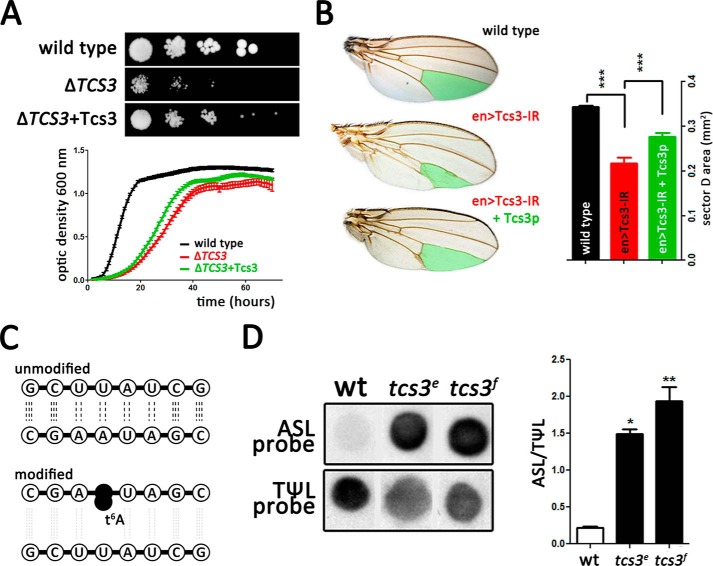FIGURE 2.
Tcs3 is required for t6A synthesis in Drosophila. A, yeasts were plated in solid media in serial dilutions of 1:10 factor from left to right. Growth differences of wild-type, TCS3 mutant cells (Δtcs3), and mutant yeasts expressing the Drosophila Tcs3 homolog (Δtcs3+Tcs3). Growth parameter of each strain was also analyzed in liquid media. Each strain has a color code (n = 10, p < 0.005). B, in Drosophila, Tcs3 was knocked-down using a specific inverted repeat construct expressed in the posterior wing compartment with the Gal4/UAS system (Tcs3-IR) and the growth phenotype evoked was rescued by yeast Tcs3p co-expression (en> Tcs3-IR+Tcs3). The area of sector D (colored in green) was measured and plotted following the same color code used in wing image labels (n = 50, mean ± S.D., t test p < 0.005). C, PHAt6A. In brief, probes designed against different regions of the initiator tRNA evidenced the presence of t6A modification. The strength of ASL probe (anti-codon stem loop) hybridization depends on the presence of t6A, whereas the TΨL probe hybridizes an unmodified base stretch and serves as an internal loading control. When t6A is absent, the tRNA-probe interaction is maximal, whereas its existence weakens the interaction. D, tRNAs from wild-type (wt) and mutant tcs3 animals (tcs3e and tcs3f) were probed with ASL and TΨL probes. Dot blots were merged to make a better composition. Also a plot depicting the change in the ASL/TΨL signal ratio is shown. ASL signals obtained from tcs3 mutants are significantly stronger than control counterparts (n = 6 samples).

